Business
Column: What would banning TikTok accomplish? Answer: Virtually nothing

In just the last few days, a couple of developments involving TikTok have arisen to illustrate the right and wrong way to think about the rapidly expanding social media platform.
The first was a devastating exposé that independent journalist Jonathan M. Katz posted there of a misleading story Sen. Katie Britt (R-Ala.) told during her official GOP response to President Biden’s State of the Union address.
In his TikTok on March 8, the day after the speech, Katz expertly demolished Britt’s claim to have interviewed an immigrant who told of having been sold out as a sex slave and Britt’s attempt to tie the story to Biden’s immigration policy — never mind that the subject’s travails took place 20 years ago, in Mexico, and had nothing to do with immigration policy.
It’s a great business and I’m going to put together a group to buy TikTok.
— Ex-Treasury Secretary Steve Mnuchin
In doing do, Katz also exposed the laziness of our own political press corps, which had to scurry to follow his lead. This was social media at its best — concise, visual and effective.
The second occurrence was the House vote Wednesday to effectively ban TikTok. The measure, which passed by a lopsided, bipartisan vote of 352 to 65, requires TikTok’s Beijing-based owner, ByteDance, to divest the platform’s U.S. operations within six months or face a nationwide ban.
The rationales put forth for the ban are varied and almost uniformly questionable. Its advocates cite the threat of Chinese government breaches of users’ privacy, its potential use as a conduit of Chinese anti-democratic propaganda into the U.S., its purportedly deleterious effect on its youthful users — one critic likened it to “opium.”
The campaign to ban TikTok deserves close scrutiny, covering such issues as who’s really behind it and why this platform is taking more heat from lawmakers than all other social media platforms put together.
The House’s headlong plunge into TikTok-banning smacks of what the fictional panjandrums of “Yes Minister” labeled “politicians’ logic”: “Something must be done; this is something; therefore, we must do it.” The thing that something must be done about is clipping the wings of the Beijing regime.
Whether targeting TikTok will advance that purpose is doubtful in the extreme. As Sir Arnold Robinson and Sir Humphrey Appleby of that classic British political farce understood, this is all about theater.
Let’s start with the huge majority of the House vote, which brought 197 Republicans together with 155 Democrats in favor. The “no” vote, however, was also bipartisan, with 50 Democrats and 15 Republicans opposed.
Capitol Hill observers chuckled over how the issue brought together the strangest of strange bedfellows, with Reps. Alexandria Ocasio-Cortez (D-N.Y.) and Marjorie Taylor Greene (R-Ga.) voting on the same side (the “no” side) possibly for the first and last time from now to the end of recorded time. The ban’s prospects in the Senate are uncertain, though President Biden has said he’d sign it if it passed.
Donald Trump, who used to advocate a ban and even tried to implement a ban while he was president, more recently reversed himself, notably after a meeting with GOP megadonor Jeff Yass, who owns 15% of ByteDance. That stake is worth about $40 billion, based on the parent company’s putative value of $268 billion as of year-end 2023. (Trump said the subject of TikTok didn’t come up during their encounter.)
Interestingly, a figure who slithered out of the woodwork as a potential buyer of TikTok if ByteDance does divest is Steven T. Mnuchin, who was Trump’s Treasury secretary. He posed less as a savior of TikTok’s users from the sinister designs of Chinese overlords than an investor spotting the main chance on the horizon. More on him in a moment.
First, let’s turn to who’s pulling the strings on a TikTok ban. One evident culprit is Meta, which owns the social media platforms Facebook, Instagram and WhatsApp.
Meta paid for an extensive publicity campaign aimed at eroding TikTok’s reputation by playing up its supposed threats to the health and welfare of young users, the Washington Post reported in 2022.
Meta’s concern isn’t hard to understand: TikTok has become more popular than any of its platforms. Social media marketing surveys indicate that the average monthly time spent on Facebook this year has been around 15.4 hours; on Instagram it’s 16.5 hours and on WhatsApp it’s 16.75 hours. On TikTok, it’s 27.9 hours.
Even worse from Meta’s standpoint, TikTok’s user base has been skewing younger than Instagram’s, its most direct competitor, and much younger than Facebook, which has been trending toward older users.
As for the suggestions that TikTok is somehow uniquely injurious to youthful users, represents a unique threat to users’ privacy, or presents a national security issue, one can only think this is some sort of a gag.
The worst serial violator of users’ privacy is arguably Meta. The company drew a record $5-billion fine from the Federal Trade Commission in 2019, when it was known as Facebook. That fine arose from Facebook’s violations of a settlement the company had reached with the government in 2012 over its previous privacy violations, as well as a habit of deceiving users into thinking their privacy was secure.
The FTC isn’t done with Meta yet; as recently as Tuesday, the agency obtained a ruling from a federal appeals court allowing it to continue investigating the company’s privacy practices, including allegations that it deceives parents about policies designed to protect children from online contacts with potential abusers.
Spreading anti-democratic propaganda? Facebook’s connections with the data firm Cambridge Analytica, which facilitated the spread of political propaganda in the presidential election and Brexit vote in 2016, have been thoroughly documented. (That’s not to excuse the Chinese regime’s appetite for censorship, or its mistreatment of ethnic minorities such as the Uyghurs.)
Anyone inclined to wring their hands over TikTok’s role in sullying public discourse and internet safety in this country must acknowledge the role of all the leading social media platforms — not only Meta but X and YouTube.
All have fallen down on the job of policing disinformation, racism, antisemitism and other forms of hate speech on their sites. X bathes in all this as examples of “free speech,” as the platform’s owner, Elon Musk, brags. All have undertaken layoffs that eviscerated their “trust and safety” teams, allowing untrustworthy and dangerous content to inundate their users.
That brings us to Mnuchin. He surfaced Thursday on CNBC and the financial press with an announcement that he was putting together an investment consortium to take TikTok off ByteDance’s hands, if the divestment becomes mandated. “It’s a great business and I’m going to put together a group to buy TikTok,” he said.
Would that make TikTok any safer for its users or democracy? Why would anyone think so? The last takeover of a social media company by a prominent individual was Musk’s acquisition of Twitter, now renamed X. From the standpoint of users or anyone interested in a civil, reliable, safe public space, that deal has been disastrous. Under Musk’s leadership, Twitter has become a sub-functional hellscape of filth that has evolved into a megaphone for its owner to pump conspiracy theories and hate speech out onto the internet.
But the ban-TikTok campaign really isn’t about any of that. As Jason Koebler of 404Media observes, a TikTok ban would “have the effect of further entrenching and empowering gigantic, monopolistic American social media companies that have nearly all of the same problems that TikTok does.”
He’s right. At its heart, TikTok today is no different from the other platforms, and it won’t become different no matter who owns it. All of them share the same business model, which is to deceive their users into thinking they’re getting a valuable service for free, when in fact the users are simply raw material to be sold to advertisers and political manipulators, en masse.

Business
Money Talk with Liz Weston: Managing mortgage debt in retirement

Dear Liz: My husband and I are Gen Xers who are renting. We have enough cash from the sale of our last home to make a small down payment on another. If we moved to a more affordable community, we could manage the payments, but it would still be a stretch. That scenario would not have bothered me 10 years ago, but now I’m close to 50. Is it a good idea to take on a mortgage at this point? What is the best way to ensure I can afford to keep the roof over my head when I can no longer work full time?
Answer: Having a mortgage in retirement used to be uncommon, but that’s no longer the case. The Joint Center for Housing Studies of Harvard University found 41% of homeowners 65 and older had a mortgage in 2022, compared with 24% in 1989. Among homeowners 80 and over, the percentage with mortgages rose from 3% to 31%.
The amounts owed have skyrocketed as well. Median mortgage debt for those 65 and older rose more than 400%, from $21,000 to $110,000 (both figures are in 2022 dollars). Median mortgage debt for those 80 and over increased more than 750%, from $9,000 to $79,000.
Mortgage debt doesn’t have to be a crisis if you can afford the home and the payments don’t cause you to run through your retirement savings too quickly. In fact, some retirees are better off hanging on to their loans. It may not make sense to prepay a 3% mortgage when you can earn 5% on a certificate of deposit, for example. Paying off a mortgage early also could leave you “house rich and cash poor,” with not enough savings to deal with emergencies and later-life expenses.
But the key is affordability. A mortgage that’s a stretch now might become easier to afford if your income rises, which was almost a given when you were younger. Now, however, you’re approaching the “dangerous decade” of your 50s, when many people wind up losing their jobs and failing to ever regain their former pay, according to a study by ProPublica and the Urban Institute.
Renting has its risks as well, of course. You aren’t building equity and you typically have little control over rent increases, other than to move.
For help in sorting through your options, consider talking to a fee-only, fiduciary advisor. Among the most affordable options are accredited financial counselors and accredited financial coaches, who typically are well-versed in the money issues facing middle-class Americans. You can get referrals from the Assn. for Financial Counseling & Planning Education at www.afcpe.org.
Dear Liz: I’m a CPA and getting conflicting answers from the Social Security office about a case I’m working on. Both clients are 70 and they’re considering legal separation or divorce. She took Social Security at 62 and receives about $1,500 a month before deductions. He started Social Security at 70 and receives about $4,600. How would her Social Security change at his death or their divorce, if she doesn’t remarry?
Answer: Based on the amounts involved, both parties are receiving their own retirement benefits and those aren’t affected by divorce, said William Reichenstein, a principal at Social Security Solutions, a claiming strategy site. (If the wife were receiving spousal benefits, those would continue after divorce as long as the marriage lasted at least 10 years and she did not remarry.)
If the husband dies and they haven’t divorced, the wife would be entitled to survivor benefits equal to his full monthly benefit amount ($4,600, plus any future cost of living increases). If they divorce and the marriage lasted at least 10 years, she also would be entitled to his full amount. Remarriage wouldn’t affect her divorced survivor benefit since she’s over 60, Reichenstein said.
Liz Weston, Certified Financial Planner®, is a personal finance columnist for NerdWallet. Questions may be sent to her at 3940 Laurel Canyon, No. 238, Studio City, CA 91604, or by using the “Contact” form at asklizweston.com.
Business
99 Cents Only to close all 371 stores and wind down its business
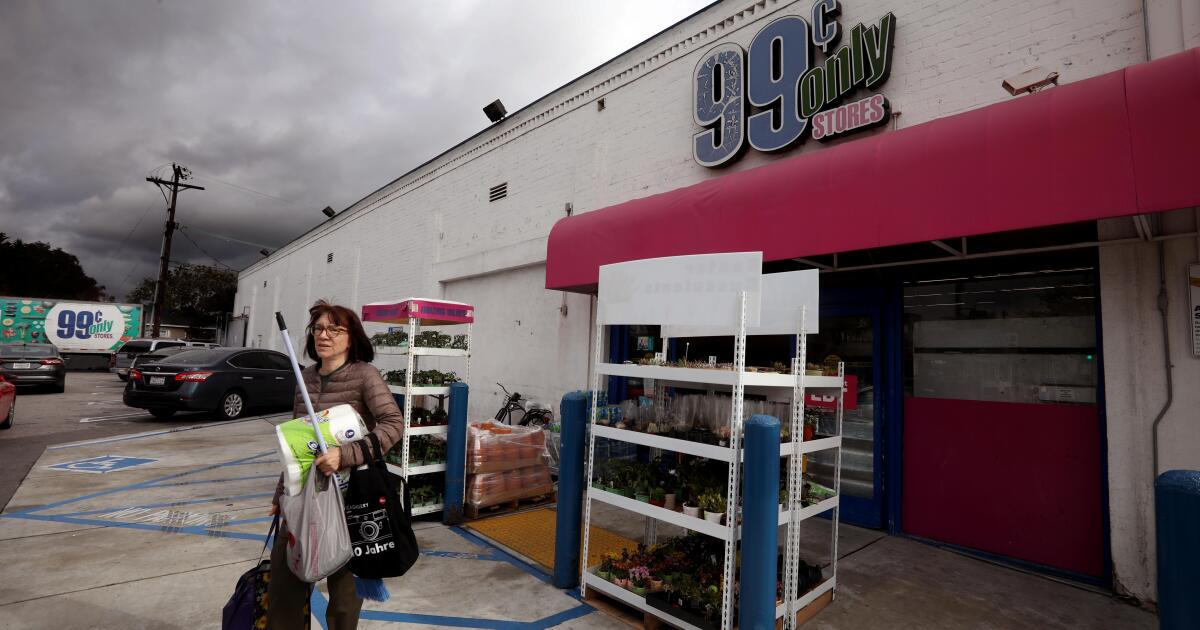
99 Cents Only Stores will close all 371 of its stores and wind down its business operations after more than four decades, the City of Commerce discount chain announced Thursday.
“This was an extremely difficult decision and is not the outcome we expected or hoped to achieve,” interim Chief Executive Mike Simoncic said in a statement. “Unfortunately, the last several years have presented significant and lasting challenges in the retail environment.”
He cited multiple factors, including the “unprecedented impact” of the COVID-19 pandemic, shifting consumer demand, persistent inflationary pressures and rising levels of shrink — an industry term that refers to loss of inventory attributed to reasons such as shoplifting, employee theft and administrative errors.
Combined, those issues “have greatly hindered the company’s ability to operate,” Simoncic said.
99 Cents Only has stores in California, Arizona, Nevada and Texas and has about 14,000 employees. The privately held company said it had reached an agreement with Hilco Global to liquidate all of its merchandise and dispose of fixtures, furnishings and equipment at its stores. Sales are expected to begin Friday.
Hilco Real Estate is managing the sale of the company’s real estate assets, which are owned or leased.
The announcement by 99 Cents Only reflects a larger weakness in the dollar-store category, said Brad Thomas, equity research analyst at KeyBanc Capital Markets.
Dollar Tree, a Chesapeake, Va., retailer, announced last month that it was closing 600 of its Family Dollar stores this year and an additional 370 in the next few years, he noted.
“It’s been trying times for many, many retailers,” he said. “What’s interesting is that what started out as a boon to retailers in the pandemic, with all those stimulus checks, quickly turned into a very troublesome time.”
Rising wages, inflation and higher losses due to shrinkage have reduced profits for retailers in a deep-discount sector where margins are already extremely low.
99 Cents Only, with its large base of California stores, has been under particular wage pressure, he said. And it’s at a disadvantage compared with larger chains such as market leader Dollar General, which has a store count close to 20,000 — “a sales base and a store base that is multiple times larger than 99 Cents,” Thomas said.
Customers make their way through the crowded parking lot at a 99 Cents Only store in Santa Monica on Friday. The chain has locations in California, Arizona, Nevada and Texas and employs about 14,000 people.
(Genaro Molina / Los Angeles Times)
Last week, Bloomberg reported that 99 Cents Only was considering a bankruptcy filing as it contended with a liquidity shortfall.
Founded in Los Angeles in 1982 by David Gold, 99 Cents Only popularized the single-price retail concept. At the time, dollar stores were seen as dumping grounds for undesirable products, but the Gold family made the stores bright and well-organized, with good-quality merchandise including groceries and household supplies.
“It was an instant success,” Howard Gold, one of David Gold’s sons, recalled Friday; he and his three siblings all worked at 99 Cents Only. “People thought it was government-subsidized because they couldn’t believe the prices.”
For years, it remained one of the few true “dollar” stores, with items priced at 99 cents or less or grouped to sell for a total of 99 cents.
That changed in 2008 when, faced with fast-rising inflation, soaring food and fuel prices, and a higher minimum wage, 99 Cents Only announced that it was straying from its long-standing price strategy.
Three years later, the company announced that it had agreed to be sold in a deal valued at about $1.6 billion, as investors eyed dollar stores that had grown in popularity during the Great Recession. In 2013, Howard Gold and the rest of the family management team departed the company.
Today, with stores scattered around Los Angeles County — among them in Hollywood, Silver Lake, Mid-Wilshire, Santa Monica, Thai Town, North Hollywood and Glendale — the closure of 99 Cents Only will leave a number of large vacant properties in prime locations.
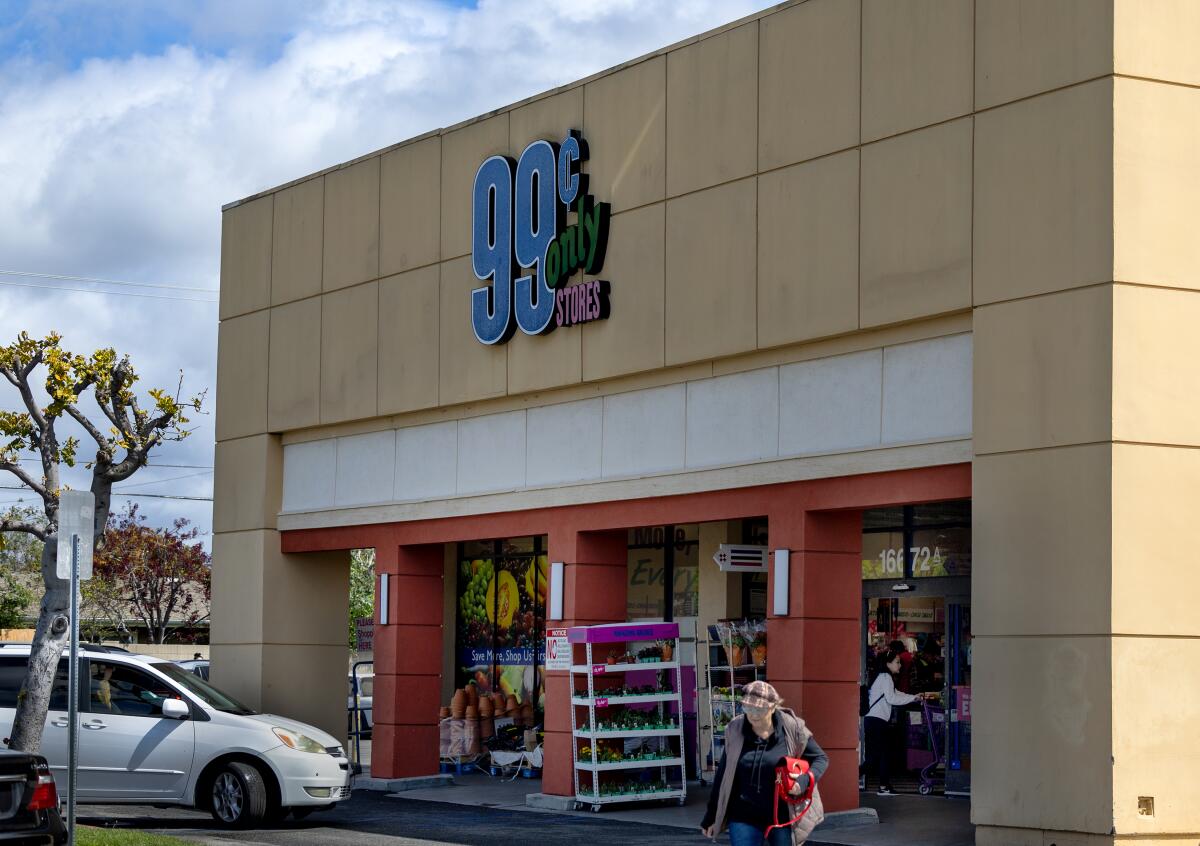
A 99 Cents Only store in Huntington Beach on Friday.
(Allen J. Schaben / Los Angeles Times)
“It’s very sad on many levels, and I’ll just leave it at that,” Gold, now retired and living in Studio City, said of the decision to close the chain his father built.
Other major retailers have also announced store closures in the region lately, including REI in Santa Monica, Macy’s in Simi Valley and several Rite Aid locations.
99 Cents Only did not respond to requests for comment.
Nicolas Kolesnikow, a retired teacher who lives in Westchester, said he was shocked to hear the chain was going out of business. He shops at a 99 Cents Only about four blocks from his house several times a week.
“It’s almost like a corner store for me,” said Kolesnikow, 82.
He might stop by and pick up milk if he runs out, and for longer trips will buy household items and produce such as tomatoes, cucumbers and cilantro before visiting a traditional supermarket with a larger selection.
Kolesnikow said he noticed that some products had become much more expensive in the last year, though there were still bargains.
“I found their prices were working their way up to regular prices,” he said, “and there were fewer shoppers.”
Business
California’s wealthiest farm family — and scores of their workers — accuse UFW of bait and trick
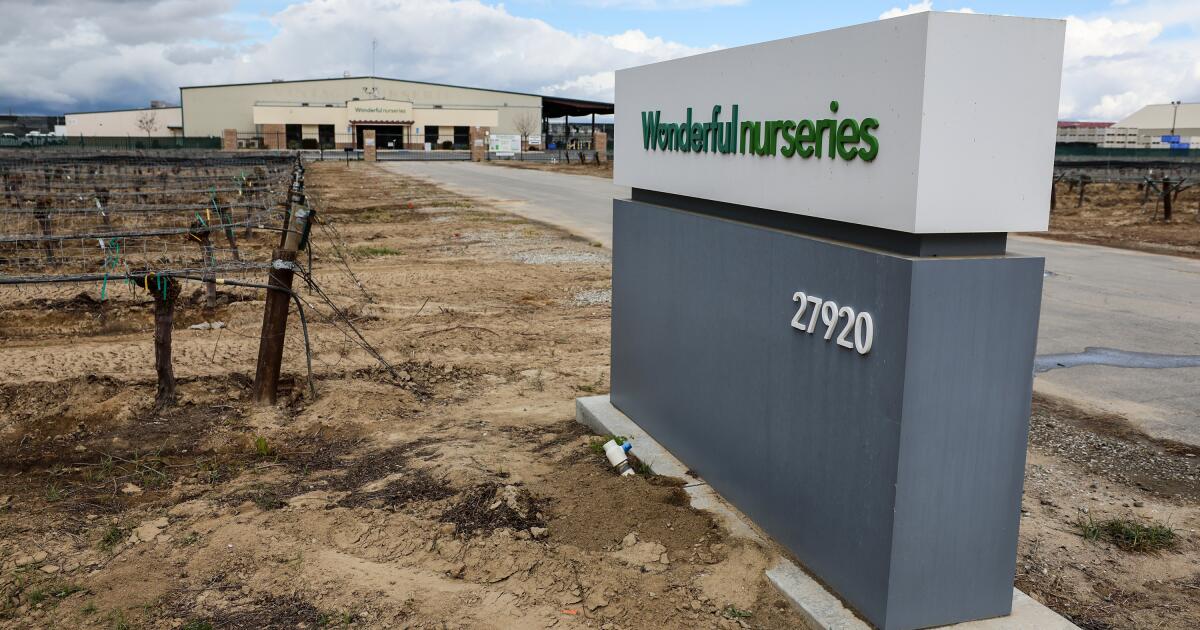
The revelation that United Farm Workers would be representing workers at a Kern County company owned by the state’s wealthiest farming family should have been a triumphant moment for the storied union co-founded by Cesar Chavez and Dolores Huerta.
Following decades of diminishing membership in the vast stretches of California’s farm fields, the UFW had seized on a new way to unionize workers, made possible by recent state legislation. Rather than hold a formal election at a company job site, union leaders had invited employees at Wonderful Nurseries, the nation’s largest grapevine nursery, to off-site meetings where they were instructed in how to apply for $600 in federal relief for farmworkers who labored during the pandemic, as well as encouraged to sign cards authorizing the UFW to represent them at Wonderful.
Labor experts say the outcome of the UFW-Wonderful skirmish could have outsize ramifications on the future of unionizing farmworkers in California.
(Max Whittaker / For the Times)
The UFW subsequently filed a petition with the Agricultural Labor Relations Board, asserting that a majority of the 600-plus farmworkers at Wonderful Nurseries in Wasco had signed the authorization cards and asking that the UFW be certified as their union representative. It appeared to mark the UFW’s third victorious unionization drive in a matter of months.
But within days, Wonderful — part of the farming empire owned by billionaires Stewart and Lynda Resnick — hit back with an explosive allegation: The company accused the UFW of using the $600 in federal relief as bait to trick farmworkers into signing the authorization cards. And it submitted nearly 150 signed declarations from nursery workers saying they had not understood that by signing the cards they were voting to unionize.

Stewart and Lynda Resnick in a 2016 portrait
(Ryan Miller / Getty Images)
Claudia Chavez, a full-time employee of a labor contractor for Wonderful Nurseries, is among several workers who told The Times that they attended meetings where they understood that the UFW would help them claim the $600. She said she was given a card to sign, but didn’t know that signing it was a vote for the union.
“They said clearly — this I do remember — that it was $600 of aid for farmworkers who worked during COVID,” Chavez, 43, said during an interview outside her Wasco home. “But they never said, ‘If you sign, we’re going to come to your work.’”
Union leaders have stood their ground, alleging that the company intimidated workers into making false statements and brought in a labor consultant with a reputation as a union buster to manipulate worker emotions in the weeks that followed.
Antonio De Loera-Brust, UFW’s communications director, called the allegations that workers were tricked into signing union cards “categorically false.” The union has put forward other workers who said they understood what they were signing and believe that UFW representation would improve their pay and working conditions.
Still, what could have been a David-versus-Goliath tale has become something tangled and far more troubling. The UFW and Wonderful are locked in battle, each employing legal muscle and PR prowess, and will present their cases to the ALRB, the state agency charged with overseeing farm labor disputes and union elections.
Labor experts say the outcome could have outsize ramifications for the future of unionizing farmworkers in California. Though still an influential voice in Democratic leadership circles, UFW has seen its on-the-ground presence and sway plummet from its vibrant heyday in the 1960s and ‘70s. At its peak, UFW had about 80,000 members across hundreds of farms. Today, that number has fallen to about 5,000, with another 2,000 in the Teamsters or United Food and Commercial Workers International unions.
If Wonderful is found to have engaged in unfair labor practices, it could be subject to financial penalties. But if the union is found to have misled workers, it faces a blow to its credibility and its nascent resurgence could be stopped in its tracks.
“One way or another it’s going to have an impact on the ability of farmworkers to organize,” said Gaspar Rivera-Salgado, project director at the UCLA Center for Labor Research and Education. “If the union fails and it’s a setback to the organizing, it’s going to be a long while before they can find a foothold to fight for farmworkers in California.”
The UFW-Wonderful skirmish is in some ways an outgrowth of a longer-running clash between labor leaders and California’s powerful agricultural interests over the UFW’s efforts to streamline the unionization process.
For years, UFW leaders had argued that the process for unionizing work sites was stacked against them. Before the new system went into effect, farmworkers voted for union representation by secret ballot at a dedicated polling event, typically held on company grounds. The UFW contends that left workers vulnerable to employer intimidation.
In 2022, Assembly Bill 2183 sought to allow farmworkers to select labor representation through mail-in ballots or a system known as card check, which allows workers to authorize a union by signing cards off-site rather than voting in-person at a designated polling place.
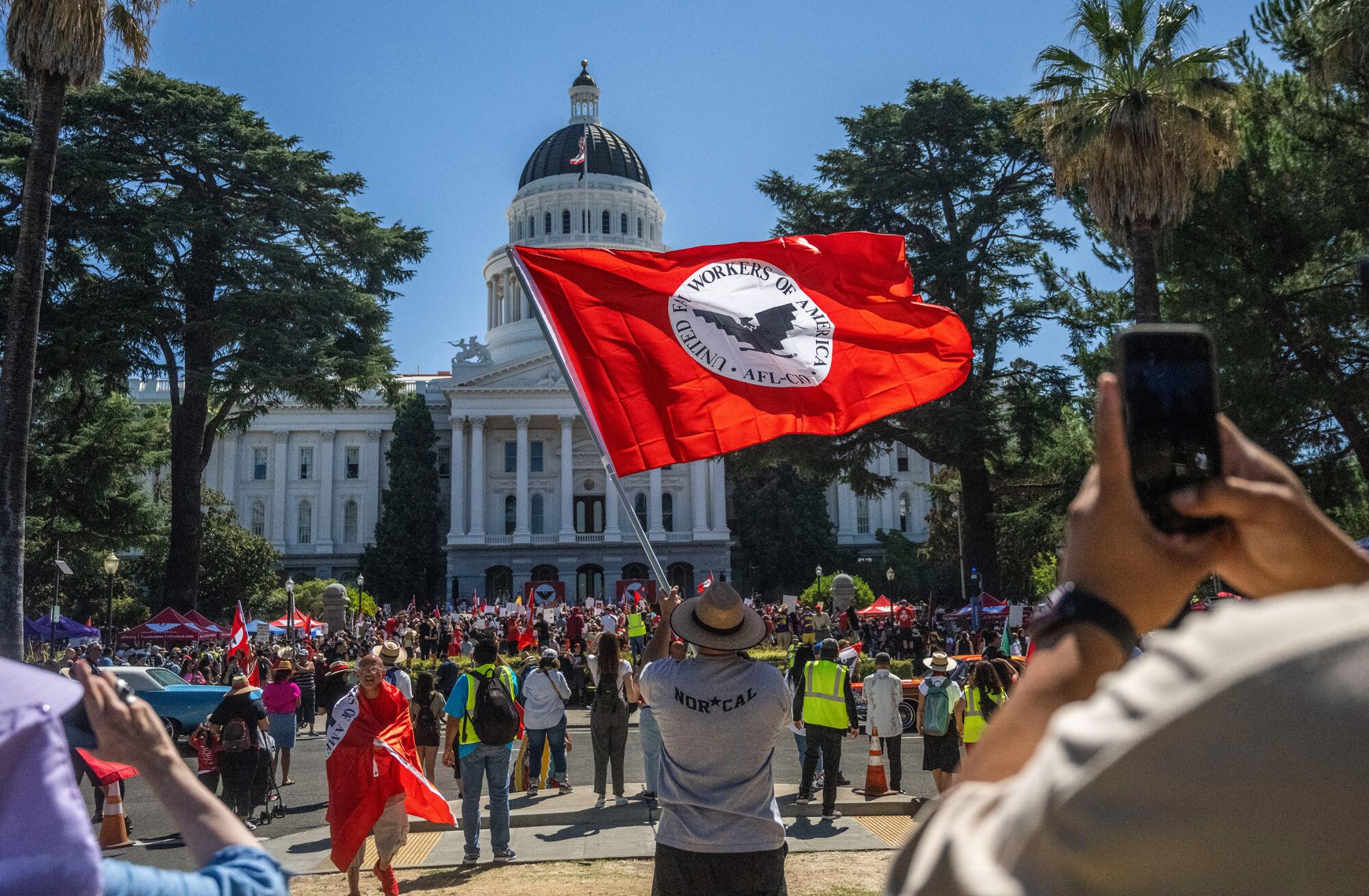
The UFW organized a 335-mile march to ramp up pressure on Gov. Gavin Newsom to sign legislation that would provide more avenues to authorize union representation at agricultural work sites.
(Hector Amezcua / The Sacramento Bee)
Gov. Gavin Newsom had vetoed a similar bill the previous year, citing concerns specific to the integrity of the mail-in balloting. His team signaled he would also veto AB 2183. But President Biden publicly exhorted Newsom to sign the bill, and the UFW organized a 335-mile march from Delano to Sacramento to ramp up pressure.
Newsom signed the bill, under the condition that it be amended to limit certain aspects. In 2023, the law was amended to remove the mail-in ballot option and cap the number of work sites that could be petitioned through card check to 75. It took effect Jan. 1, 2023, and will sunset in 2028.
Under the new system, a union can seek to organize an agricultural work site without notifying an employer. Once union representatives gather enough authorization cards to constitute what they believe is majority support, the union files a petition with the state labor board and the employer. The ALRB must decide whether there is proof a majority of the bargaining unit employees support forming a union.
But as is playing out in the Wonderful case, that process can be appealed.
From the start, the new system has been shadowed by a lack of specifics on the responsibilities of the union and employers in the card check drive. It has taken the ALRB 10 months to publish proposed regulations for the new law, and growers say they feel they’ve been playing a game with no rules.
UFW’s first certification petition under card check landed in Stanislaus County in September when it sought to represent 250 workers at DMB Packing Corp., also known as DiMare, where it won 51% support. DiMare submitted several objections, including an allegation that the union obtained signatures through “fraud” and “coercion.” The ALRB found the allegations lacked evidence.
Guadalupe Luna, 55, said working conditions at the tomato packing company in Newman were miserable — that they had no health benefits, no paid time off and got paid 77 cents for every bucket of tomatoes collected. Before Luna arrived at the farm about a year ago, he said, he worked on a farm in Firebaugh where the UFW represented workers and they received benefits and better pay.
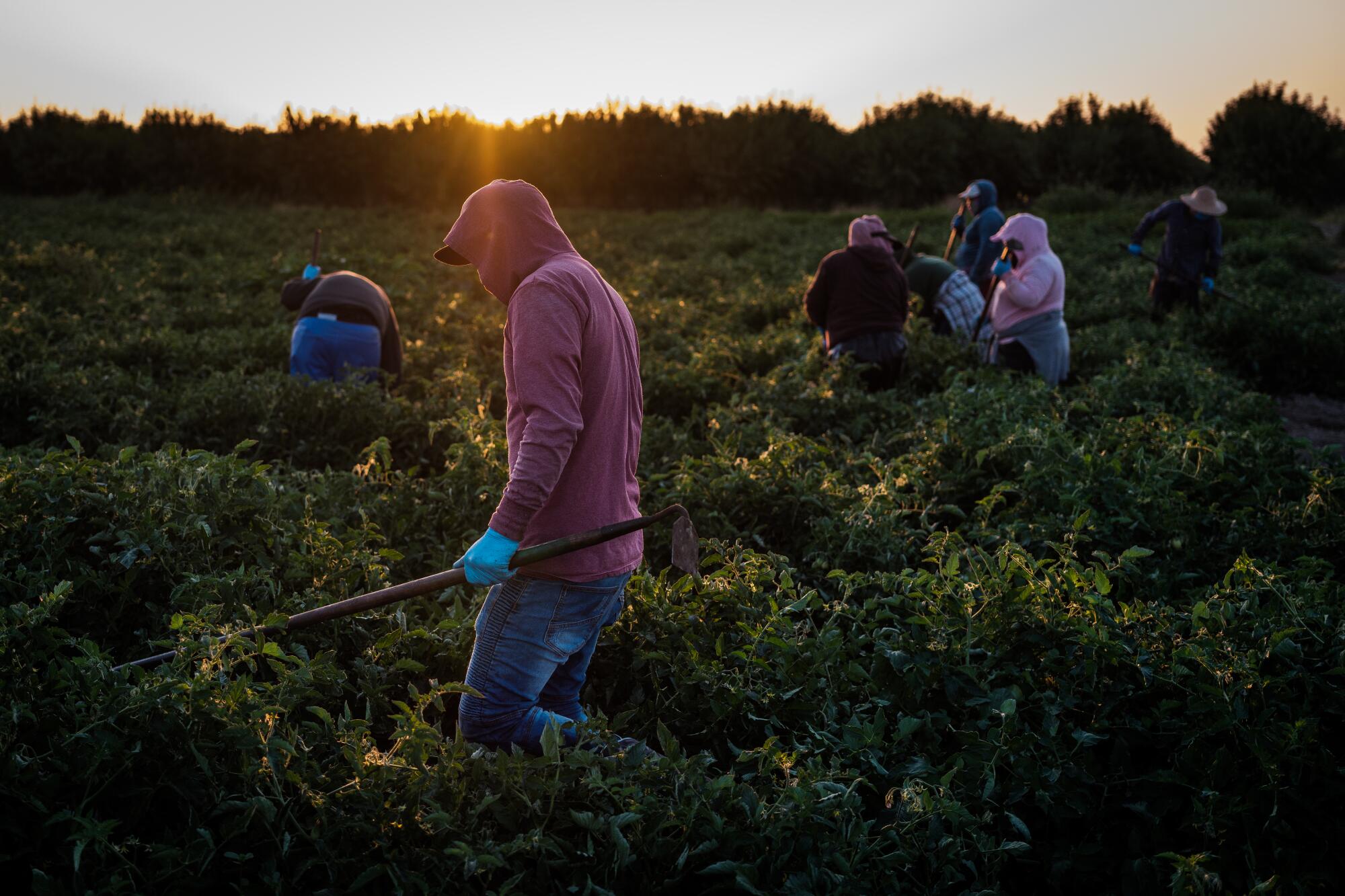
Though still an influential voice in Democratic leadership circles, the UFW has seen its on-the-ground presence plummet from its vibrant heyday in the 1960s and ‘70s.
(Max Whittaker / For the Times)
Luna, who is on the bargaining committee for the union, said the UFW meetings he attended with co-workers were focused on the benefits of unionizing and did not include conversations about the $600 federal relief payments. “The coworkers I spoke with, we talked and there wasn’t that [confusion].” he said. “We just talked to them and explained the process.”
DMB Packing President Jeff Dolan said the company is appealing the labor board’s decision. Nonetheless, he said, negotiations with the UFW and workers have been “cordial and positive.”
In Fallbrook, 50 miles north of San Diego, the UFW submitted a petition in January to represent more than 70 employees at Olive Hill Greenhouses. According to the ALRB, no objections were filed, and both sides are at the table to negotiate their first contract.
Santiago Hernandez was among those eager to unionize workers at the Fallbrook nursery. He said he told colleagues to talk to a UFW organizer and explain what they wanted out of their jobs and decide if they wanted to support a union.
The first meeting, he said, was about starting a union and they received the authorization cards to consider. He said the last meeting he attended, where people could drop off the cards, also allowed people to sign up for the $600 in relief. He did not hear from colleagues about being tricked, he said, and felt it had been clearly communicated that the two were not linked.
“The union is here to help farmworkers, not to screw with farmworkers,” Hernandez said.
One of the largest employers in the Central Valley, the Wonderful Co. prides itself on its treatment of farmworkers, including paying above minimum wage and extending company benefits — like free use of its health centers and gyms — to full-time employees. Wonderful has also invested millions of dollars in farmworker communities in Kern County, building parks and schools and improving infrastructure.
The Resnicks, owners of FIJI Water, Wonderful Pistachios and POM Wonderful, are major political donors who have contributed more than $220,000 to Newsom’s campaigns alone.
The workers at Wonderful Nurseries’ sprawling complex in Wasco tend to wine and table grapevines and nut tree rootstocks. In both the company and union narratives about the card check episode, the workers have been portrayed as pawns in a much larger game. The divergent narratives offer little room for a middle ground, for example whether there could have been some confusion in the meetings because of a general lack of understanding of the UFW’s role.
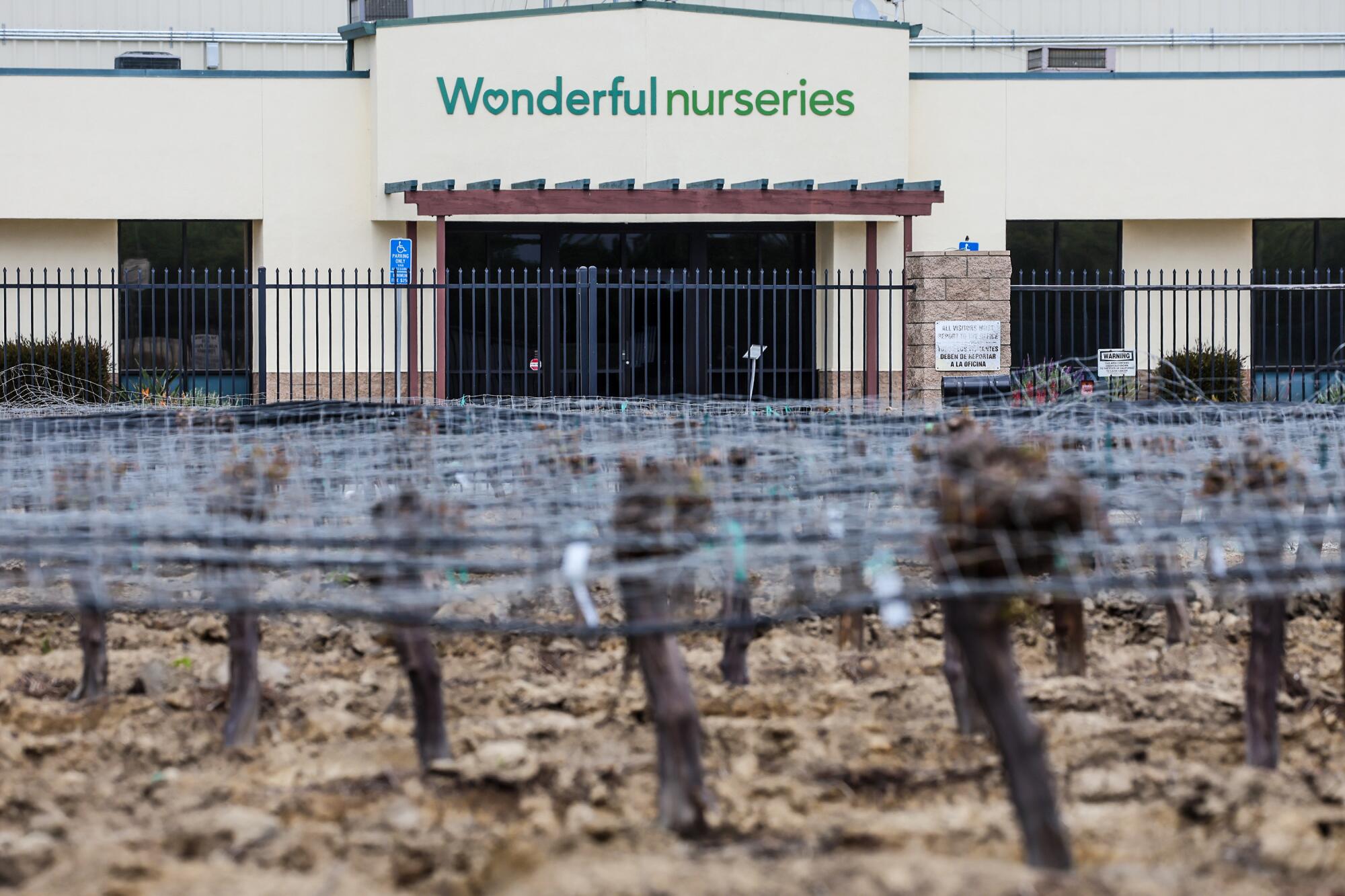
One of the largest employers in the Central Valley, the Wonderful Co. has invested millions of dollars in farmworker communities in Kern County.
(Robert Gauthier / Los Angeles Times)
There does seem to be general agreement that the organizing meetings for Wonderful employees incorporated discussion of both the federal relief payments and the unionization drive. The U.S. Department of Agriculture has authorized several organizations to distribute the one-time grants, including the UFW Foundation, which is separate from the labor union.
Rosa Maria Silva de Rodriguez, 40, who has worked at Wonderful Nurseries for five years, said she hosted several of the meetings at her home last year. She said she wants a union because she feels workers are being mistreated. The water provided in 5-gallon coolers was inconsistently refilled and cleaned, she said. She said she’s had uncomfortable situations in which male coworkers made suggestive comments about women and she knew of no avenue for reporting it.
Silva de Rodriguez said it was clear at the meetings that the federal relief money was not tied to signing a union card. The UFW representative “always talked about the rights of workers, what it meant to form a union, to bring in a union, what the union would do,” Silva de Rodriguez said.
Yet other workers interviewed by The Times spoke in equally heartfelt terms about feeling duped.
Maria Pedro, 27, makes $16.30 an hour as a seasonal worker for a labor contractor at Wonderful Nurseries. She likes that the work in the greenhouses is indoors — and therefore dependable, even when it rains.
“Look, I just got home, and I’m clean,” Pedro said on a recent afternoon, as she sat at a table in her work clothes, khaki-colored pants and a black, long-sleeved shirt.

The workers at Wonderful Nurseries’ sprawling complex in Wasco tend to wine and table grapevines and nut tree rootstocks.
(Robert Gauthier / Los Angeles Times)
She described attending a meeting last year at a colleague’s home in Wasco. She said a UFW representative was there to help Pedro and others apply for the $600 federal grant. As a single mother of three, the money would help her pay rent and buy diapers.
Pedro, who emigrated from Guatemala five years ago, said she had never heard of the union. But during the meeting, the rep explained that the organization helps farmworkers assert their rights. Pedro signed several documents. Among them was a white card emblazoned with the union’s eagle logo that reads, in English and Spanish, “I authorize the Union of Farm Workers of America to be my union representative to collectively negotiate an employment contract with my employer to improve my wages, working conditions and benefits.”
The union rep never asked if the workers wanted to join the union and didn’t explain the significance of the cards, Pedro said.
On Feb. 23, the UFW filed a petition with the ALRB to represent Wonderful Nurseries employees. Several workers, including people for and against unionizing, described attending meetings days later, led by an outside consultant, Raul Calvo, who has built a business advising farm companies on how to avoid unionization. The workers said Calvo told them about the union’s entrance into Wonderful Nurseries and that once the contract was ratified, 3% of their paycheck would go toward union dues.
Pedro said it was only then that she realized that, by signing the card, she had voted for the UFW to represent her. “Thanks to him, we understood what was happening, because the union never really explained what they did,” she said.
If her name was on the petition, Pedro said, she wanted it removed and asked Wonderful for help. She was among the workers who signed a declaration.
Silva de Rodriguez, on the other hand, contends Calvo was the first to suggest employees were tricked. She said workers began admitting to supervisors that they had signed the union card and faced pressure to renounce their support. She said she has seen workers who once supported the unionization effort now protest against it.
“It bothers me, but at the same time, it gives me a bit more strength, because I am fighting for something fair, something fair for everyone,” she said.
The union filed a charge against Wonderful Nurseries, alleging the company required workers to attend a “captive audience” meeting to urge employees to reject UFW representation. Wonderful Nurseries maintains it “provided interested employees with factual information about the process and their rights.”
Calvo confirmed to The Times he is working for the company but declined to answer questions about his role.
The ALRB acknowledged receiving worker declarations on March 1 and called the allegations “serious in nature.” Three days later, the regional director of the labor board moved forward to certify the union’s petition, determining the UFW had submitted 327 valid authorization cards from a bargaining unit of 640, establishing majority support.
The dispute crystallized last week when about 100 Wonderful Nurseries workers left work and traveled 60 miles north to the labor board’s Visalia office. They sported the orange safety vests they’re required to wear at work and carried signs reading, “We don’t want a union! Listen to our voices. Don’t ignore us.”
While the company and two participants who spoke with The Times were adamant the demonstration was worker-led, the UFW has filed a charge with the board alleging that Wonderful Nurseries coerced workers into attending.

About 100 employees of Wonderful Nurseries who say the UFW used deceptive tactics in its unionization drive stage a protest at the Agricultural Labor Relations Board in Visalia.
(Courtesy of Claudia Chavez)
Last week, in yet another escalation, a Central Valley law firm that frequently represents the UFW filed charges with the state Civil Rights Department on behalf of seven workers, including Silva de Rodriguez, alleging that Wonderful Nurseries doesn’t provide sexual harassment training, resulting in a “hostile work environment.”
Wonderful fired back, dismissing the charges as “bogus claims.” In a statement, company President Rob Yraceburu said every manager, including those employed through third parties, is in compliance with all mandatory training, and that the company provided the UFW with its employee handbook, which includes its harassment policy, a week before the charges were filed.
“It’s getting harder to keep up with the fire hose of lies the UFW is pushing in their effort to divert attention from their fraudulent conduct in a vote decided by just seven votes, but where more than 150 farmworkers say they were misled,” Yraceburu said.
Wonderful has appealed the UFW certification. The state labor board is expected to meet this month to consider the company’s objections.
This article is part of The Times’ equity reporting initiative, funded by the James Irvine Foundation, exploring the challenges facing low-income workers and the efforts being made to address California’s economic divide.
-

 Kentucky1 week ago
Kentucky1 week agoKentucky first lady visits Fort Knox schools in honor of Month of the Military Child
-

 World1 week ago
World1 week agoEU leaders weigh Lebanon partnership in response to Middle East crisis
-

 Politics1 week ago
Politics1 week agoFormer Wisconsin Democratic Rep. Peter Barca launches congressional comeback bid
-

 Movie Reviews1 week ago
Movie Reviews1 week agoFilm Review: Challengers – The Knockturnal
-

 World1 week ago
World1 week agoShipping firms plead for UN help amid escalating Middle East conflict
-

 World1 week ago
World1 week agoIsraeli attack on nuclear sites to prompt tit-for-tat, pursuing nukes: Iran
-

 World1 week ago
World1 week agoIranian media says three drones downed after explosions heard in Isfahan
-
News1 week ago
Maryland high school student arrested after authorities discovered a 129-page document detailing school shooting plan, police say | CNN
















